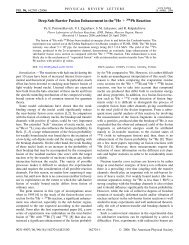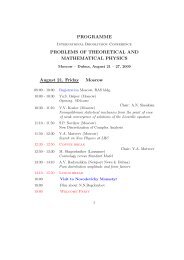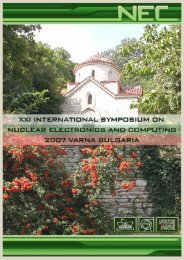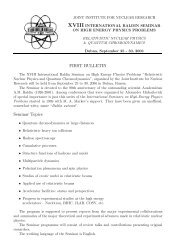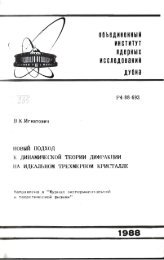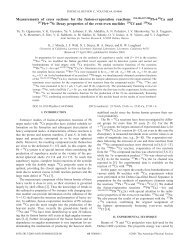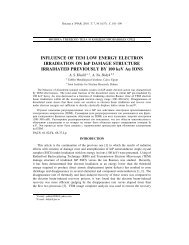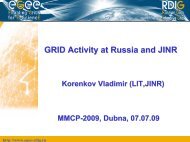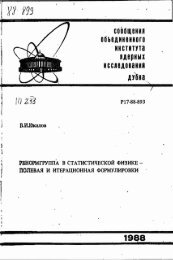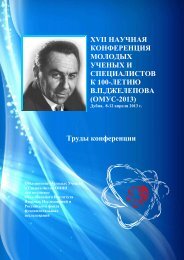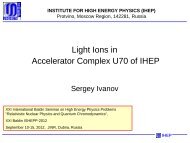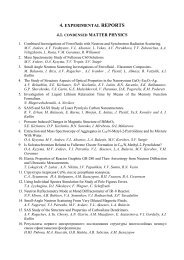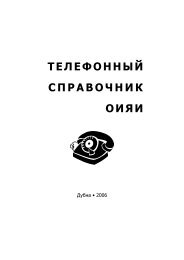Joint Institute for Nuclear Research Relativistic ... - Index of - JINR
Joint Institute for Nuclear Research Relativistic ... - Index of - JINR
Joint Institute for Nuclear Research Relativistic ... - Index of - JINR
Create successful ePaper yourself
Turn your PDF publications into a flip-book with our unique Google optimized e-Paper software.
RADIOACTIVE NUCLEI STOPPED IN NUCLEAR TRACK EMULSION<br />
D.A. Artemenkov 1†<br />
(1) V. I. Veksler and A. M. Baldin Laboratory <strong>of</strong> High Energy Physics<br />
<strong>Joint</strong> Insitute <strong>for</strong> <strong>Nuclear</strong> <strong>Research</strong>, Dubna, Russia<br />
† E-mail: artemenkov@lhe.jinr.ru<br />
In the energy range <strong>of</strong> nuclei several MeV per nucleon, there is a possibility <strong>of</strong> implantation<br />
<strong>of</strong> radioactive nuclei into detector material. Of course, in this approach daughter<br />
nuclei are investigated rather than the nuclei themselves. In this respect it is worth mentioning<br />
the known, although somewhat <strong>for</strong>gotten, possibilities <strong>of</strong> NTE <strong>for</strong> the detection<br />
<strong>of</strong> slow radioactive nuclei. More than half a century ago, “hammer” tracks from the decay<br />
<strong>of</strong> 8 Be nuclei through the first excited state 2 + <strong>of</strong> about 2.0 MeV were observed in<br />
NTE. They occurred in the α decays <strong>of</strong> stopped 8 Li and 8 B fragments, which in turn<br />
were produced by high-energy particles. Another example is the first observation <strong>of</strong> the<br />
9 C nucleus from the decay 2α + p. When used with sufficiently pure secondary beams,<br />
NTE appears to be an effective means <strong>for</strong> a systematic study <strong>of</strong> the decay <strong>of</strong> light nuclei<br />
with an excess <strong>of</strong> both neutrons and protons. In NTE the directions and ranges <strong>of</strong> the<br />
beam nuclei and slow products <strong>of</strong> their decay can be measured, which provides a basis <strong>for</strong><br />
α spectrometry. A question <strong>of</strong> major importance is to supplement the 3α spectroscopy <strong>of</strong><br />
12 N and 12 B decays with data on 3α angular correlations.<br />
In March 2012 NTE was exposed at the Flerov Laboratory <strong>of</strong> <strong>Nuclear</strong> Reactions<br />
(<strong>JINR</strong>) at the ACCULINNA spectrometer . The beam in use was enriched by 7 A MeV<br />
8 He nuclei. A 107 µm thick NTE pellicle was oriented at a 10 ◦ angle during irradiation,<br />
which provided approximately a five-fold effective thickness increase. For ten minutes<br />
<strong>of</strong> irradiation, statistics <strong>of</strong> about two thousand <strong>of</strong> such decays was obtained. It is<br />
pleasant to note that the used NTE have been recently reproduced by the enterprises<br />
“Slavich” (Pereslavl-Zalessky, Russia).<br />
23



